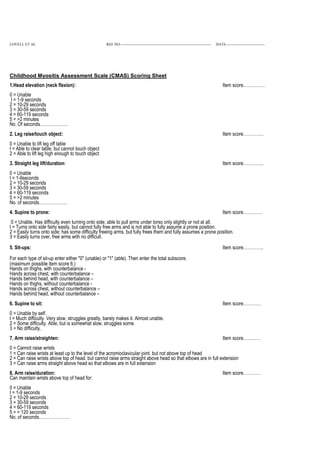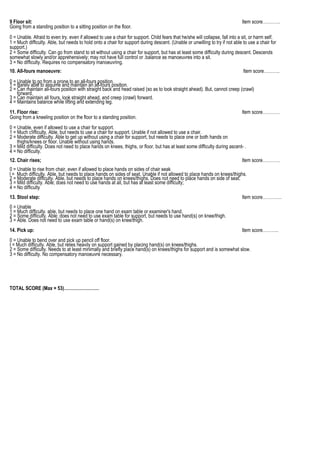Cmas
- 1. LOVELL ET AL REF NO:------------------------------------------------------------------------ DATE------------------------------- Childhood Myositis Assessment Scale (CMAS) Scoring Sheet 1.Head elevation (neck flexion): Item scoreâĶâĶâĶâĶâĶ 0 = Unable I = 1-9 seconds 2 = 10-29 seconds 3 = 30-59 seconds 4 = 60-119 seconds 5 = >2 minutes No. Of secondsâĶâĶâĶâĶâĶâĶ. 2. Leg raise/touch object: Item scoreâĶâĶâĶâĶ.. 0 = Unable to lift leg off table I = Able to clear table, but cannot touch object 2 = Able to lift leg high enough to touch object 3. Straight leg lift/duration: Item scoreâĶâĶâĶâĶ.. 0 = Unable I = 1-9seconds 2 = 10-29 seconds 3 = 30-59 seconds 4 = 60-119 seconds 5 = >2 minutes No. of secondsâĶâĶâĶâĶâĶâĶ. 4. Supine to prone: Item scoreâĶâĶâĶâĶ. 0 = Unable. Has difficulty even turning onto side; able to pull arms under torso only slightly or not at all. I = Turns onto side fairly easily, but cannot fully free arms and is not able to fully assume a prone position. 2 = Easily turns onto side; has some difficulty freeing arms, but fully frees them and fully assumes a prone position. 3 = Easily turns over, free arms with no difficult. 5. Sit-ups: Item scoreâĶâĶâĶâĶ.. For each type of sit-up enter either "0" (unable) or "1" (able). Then enter the total subscore. (maximum possible item score 6.) Hands on thighs, with counterbalance - Hands across chest, with counterbalance â Hands behind head, with counterbalance â Hands on thighs, without counterbalance - Hands across chest, without counterbalance â Hands behind head, without counterbalance â 6. Supine to sit: Item scoreâĶâĶâĶâĶ 0 = Unable by self. I = Much difficulty. Very slow, struggles greatly, barely makes it. Almost unable. 2 = Some difficulty. Able, but is somewhat slow, struggles some. 3 = No difficulty. 7. Arm raise/straighten: Item scoreâĶâĶâĶâĶ 0 = Cannot raise wrists 1 = Can raise wrists at least up to the level of the acromioclavicular joint. but not above top of head 2 = Can raise wrists above top of head. but cannot raise arms straight above head so that elbows are in full extension 3 = Can raise arms straight above head so that elbows are in full extension 8. Arm raise/duration: Item scoreâĶâĶâĶâĶ Can maintain wrists above top of head for: 0 = Unable I = 1-9 seconds 2 = 10-29 seconds 3 = 30-59 seconds 4 = 60-119 seconds 5 = > 120 seconds No. of secondsâĶâĶâĶâĶâĶâĶâĶ
- 2. 9 Floor sit: Item scoreâĶâĶâĶâĶ Going from a standing position to a sitting position on the floor. 0 = Unable. Afraid to even try. even if allowed to use a chair for support. Child fears that he/she will collapse, fall into a sit, or harm self. 1 = Much difficulty. Able, but needs to hold onto a chair for support during descent. (Unable or unwilling to try if not able to use a chair for support.) 2 = Some difficulty. Can go from stand to sit without using a chair for support, but has at least some difficulty during descent. Descends somewhat slowly and/or apprehensively; may not have full control or .balance as manoeuvres into a sit. 3 = No difficulty. Requires no compensatory manoeuvring. 10. All-fours manoeuvre: Item scoreâĶâĶâĶ.. 0 = Unable to go from a prone 1 = Barely able to assume andtmo aainntaaliln-foaunrsalpl-ofosuitriosnp.osition. 2 = Can maintain all-fours position with straight back and head raised (so as to look straight ahead). But, cannot creep (crawl) forward. 3 = Can maintain all fours, look straight ahead, and creep (crawl) forward. 4 = Maintains balance while lifting and extending leg. 11. Floor rise: Item scoreâĶâĶâĶâĶ Going from a kneeling position on the floor to a standing position. 0 = Unable, even if allowed to use a chair for support. 1 = Much c!ifficulty, Able, but needs to use a chair for support. Unable if not allowed to use a chair. 2 = Moderate difficulty. Able to get up without using a chair for support, but needs to place one or both hands on thighs/knees or floor. Unable without using hands. 3 = Mild difficulty. Does not need to place hands on knees, thighs, or floor, but has at least some difficulty during ascent- . 4 = No difficulty. 12. Chair rises; Item scoreâĶâĶâĶâĶ 0 = Unable to rise from chair, even if allowed to place hands on sides of chair seak l = Much difficulty. Able, but needs to place hands on sides of seat. Unable if not allowed to place hands on knees/thighs. 2 = Moderate difficulty. Able, but needs to place hands on knees/thighs. Does not need to place hands on side of seat. 3 = Mild difficulty. Able; does not need to use hands at all, but has at least some difficulty; 4 = No difficulty 13. Stool step: Item scoreâĶâĶâĶâĶ. 0 = Unable 1 = Much difficulty. able, but needs to place one hand on exam table or examiner's hand. 2 = Some difficulty. Able; does not need to use exam table for support, but needs to use hand(s) on knee/thigh. 3 = Able. Does not need to use exam table or hand(s) on knee/thigh. 14. Pick up: Item scoreâĶâĶâĶ.. 0 = Unable to bend over and pick up pencil off floor. I = Much difficulty. Able, but relies heavily on support gained by placing hand(s) on knees/thighs. 2 = Some difficulty. Needs to at least minimally and briefly place hand(s) on knees/thighs for support and is somewhat slow. 3 = No difficulty. No compensatory manoeuvre necessary. TOTAL SCORE (Max = 53)âĶâĶâĶâĶâĶâĶâĶâĶ

